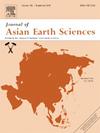Regional-scale exploration targeting of REEs associated with Kiruna-type Iron Oxide-Apatite mineralization in the Bafq-Saghand metallogenic province, Central Iran
IF 2.7
3区 地球科学
Q2 GEOSCIENCES, MULTIDISCIPLINARY
引用次数: 0
Abstract
The Bafq-Saghand metallogenic province, situated in the Central Iranian geo-structural zone, hosts world-class Kiruna-type Iron Oxide-Apatite (IOA) deposits, accompanied by local Rare Earth Elements-Uranium-Thorium (REEs–U–Th) enrichment. Its favorable geological setting holds significant potential for the discovery of REEs mineralization. However, the processes governing the formation, development and preservation of REEs are inadequately understood. Recognizing the processes leading to REEs formation and mapping their spatial expressions are crucial factors for mineral prospectivity mapping and subsequent exploration activities. This research aims to delineate exploration targets for REEs associated with IOA deposits, employing a Mamdani-type fuzzy inference system (FIS) technique and concentration–area fractal method. The regional-scale targeting criteria for IOA-associated REEs deposits were identified using mineral systems approach. The inputs for the mineral prospectivity model were the spatial proxies derived from geoscientific datasets comprising geological, remote sensing, geophysical, and geochemical data. The output prospectivity map highlights high-prospectivity REEs target areas covering approximately 10% of the entire region, displaying an NNW-SSE trending pattern similar to the crustal faults of the region, mainly associated with metasomatized acidic volcanic and metamorphosed volcanic rock units. This research led to identification of prospective target areas, where detailed project-scale exploration study is recommended and the demonstrated strategy in this research can be applied to demarcate exploration targets in similar geological terranes elsewhere.

伊朗中部Bafq-Saghand成矿省kiruna型氧化铁磷灰石成矿相关稀土元素的区域尺度勘查
Bafq-Saghand成矿省位于伊朗中部地质构造带,拥有世界级的kiruna型氧化铁-磷灰石(IOA)矿床,并伴有当地稀土元素-铀-钍(ree - u - th)富集。有利的地质环境对稀土矿化的发现具有重要的潜力。然而,稀土元素形成、发育和保存的过程尚不清楚。认识稀土元素形成过程并绘制其空间表达式是矿产远景填图和后续勘探活动的关键因素。利用mamdani型模糊推理系统(FIS)技术和浓度-面积分形方法,圈定与IOA矿床伴生稀土的找矿目标。利用矿物系统方法确定了ioa伴生稀土矿床的区域尺度定位标准。矿产远景模型的输入是来自地质、遥感、地球物理和地球化学数据的地球科学数据集的空间代用物。产出远景图显示,高远景稀土靶区约占全区的10%,呈现NNW-SSE走向,与该区地壳断裂相似,主要与交代酸性火山岩和变质火山岩单元有关。这项研究确定了未来的目标区域,建议在这些区域进行详细的项目规模的勘探研究,并且本研究中展示的策略可以应用于其他类似地质地块的勘探目标。
本文章由计算机程序翻译,如有差异,请以英文原文为准。
求助全文
约1分钟内获得全文
求助全文
来源期刊

Journal of Asian Earth Sciences
地学-地球科学综合
CiteScore
5.90
自引率
10.00%
发文量
324
审稿时长
71 days
期刊介绍:
Journal of Asian Earth Sciences has an open access mirror journal Journal of Asian Earth Sciences: X, sharing the same aims and scope, editorial team, submission system and rigorous peer review.
The Journal of Asian Earth Sciences is an international interdisciplinary journal devoted to all aspects of research related to the solid Earth Sciences of Asia. The Journal publishes high quality, peer-reviewed scientific papers on the regional geology, tectonics, geochemistry and geophysics of Asia. It will be devoted primarily to research papers but short communications relating to new developments of broad interest, reviews and book reviews will also be included. Papers must have international appeal and should present work of more than local significance.
The scope includes deep processes of the Asian continent and its adjacent oceans; seismology and earthquakes; orogeny, magmatism, metamorphism and volcanism; growth, deformation and destruction of the Asian crust; crust-mantle interaction; evolution of life (early life, biostratigraphy, biogeography and mass-extinction); fluids, fluxes and reservoirs of mineral and energy resources; surface processes (weathering, erosion, transport and deposition of sediments) and resulting geomorphology; and the response of the Earth to global climate change as viewed within the Asian continent and surrounding oceans.
 求助内容:
求助内容: 应助结果提醒方式:
应助结果提醒方式:


